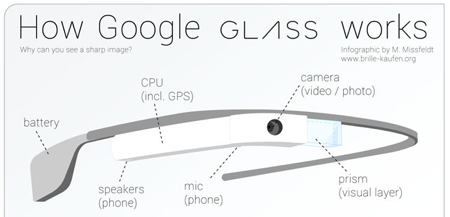A Visual Explanation of Google Glass, and the Truth About E-Books
This is part of our series of weekly roundups curating the best higher education technology news, articles and resources from around the web. Use the hashtag #higheredreads to suggest an article. For easy reading on any mobile device, download these stories as a Readlist.
How, Exactly, Does Google Glass Work?
There has been a lot of discussion about Google Glass among those higher education but precious few people understand how this technology actually works. Luckily, artist Martin Missfeldt created an infographic to break it down:
The core feature of Google Glass is a visual layer that is placed over the reality ("augmented reality"). This layer opens a door to amazing new possibilities. But how does it work? In the Google Glass contains a mini-projector, which projected the layer via a clever, semi-transparent prism directly on the retina in the eye. Because of this the image, even though it is so close to the eye, is sharp and clear. You can move the front part of the Google Glass easily to optimize the focus.
See the full infographic here.

The Truth About E-Books
A report on e-books was brought to our attention by reader Serena Franken on Twitter. The data suggest that e-books are not ready for adoption by most college students, because they “prefer print” and find e-textbooks to be “clumsy.”
Students praised the e-books for helping them save money but didn’t like reading on electronic devices. Many of them complained that the e-book platform was hard to navigate. In addition, most professors who responded said that they didn’t use the e-books’ collaborative features, which include the ability to share notes or create links within the text.
As much as we laud technology’s advances, not all of them are ready for the classroom. What are your thoughts on e-books? Let us know in the Comments section below, and read the full article on The Chronicle of Higher Education.
The Monetization of Coursera Begins
The courses are massive and open (read free ), but that doesn’t mean money isn’t changing hands. With over 3 million users, Coursera needs a way to generate revenue. It appears they have found a real source:
The Silicon Valley-based company brought in $220,000 in the first quarter after it started charging for verified completion certificates, its co-founders said. The company also receives revenue from an Amazon.com affiliates program if users buy books suggested by professors.
“It’s the beginning of revenue,” said a Coursera co-founder, Daphne Koller.
The company has 3.2 million registered users, an increase of nearly 700,000 from mid-February. The company was founded in fall 2011 by Koller and her colleague at Stanford University, Andrew Ng.
Read more on Inside Higher Ed.
Send us a tweet at @EdTech_Highered to suggest stories for next week.








